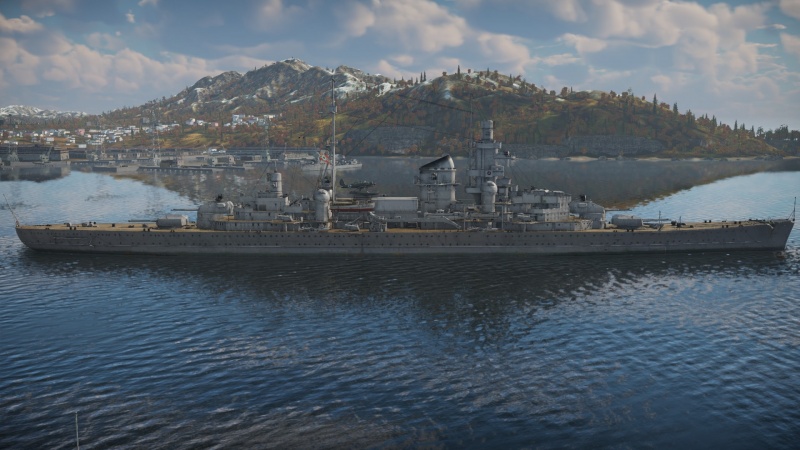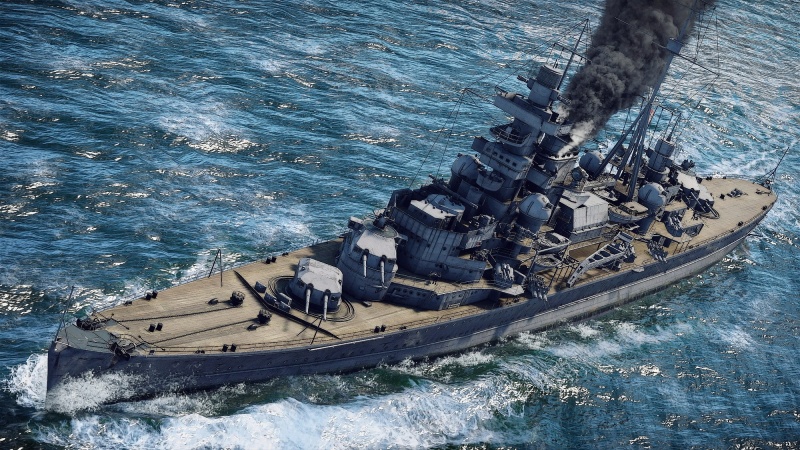Admiral Hipper
Contents
Description
The Admiral Hipper-class, Admiral Hipper, 1942 is a rank IV German heavy cruiser with a battle rating of 5.7 (AB/RB/SB). It was introduced in Update 1.91 "Night Vision".
General info
Survivability and armour
The Admiral Hipper, lead ship of her class, is one of the most powerful cruisers in the German bluewater fleet, featuring a comprehensive armour scheme that can be quite resilient against cruiser gunfire. Due to her intended purpose as a raider capable of capturing merchant ships, the Hipper has an unusually high crew count, which would have been used to crew captured ships in real life, but serves as an extra buffer of crew in game. However, she possesses a few fatal and well-known weak spots: both frontal and rear magazines are massive and very prone to detonation should an opposing player be able to penetrate their armour.
Mobility
Write about the ship's mobility. Evaluate its power and manoeuvrability, rudder rerouting speed, stopping speed at full tilt, with its maximum forward and reverse speed.
| Mobility Characteristics | |||
|---|---|---|---|
| Game Mode | Upgrade Status | Maximum Speed (km/h) | |
| Forward | Reverse | ||
| AB | |||
| Upgraded | 70 | 25 | |
| RB/SB | |||
| Upgraded | 60 | 22 | |
Modifications and economy
Armament
Primary armament
The Admiral Hipper's primary armaments consists of eight 203 mm/60 SK C/34 cannons arranged in four twin turrets mounted A-Bs-Xs-Y. The guns are notable for being effective at dealing damage to all kinds of targets, save for battleships at range. The guns have a good reload time of 12 seconds (ace crew) and have a decent firing arc, giving the Admiral Hipper a consistent damage output against enemy ships.
The 203 mm guns have three shell choices; a HE shell with 8.8 kg TNTe, a SAP shell with decent penetration (160 mm at 10 km) and sizeable filler of 5.35 kg TNTe, and a powerful APCBC shell which has very high penetration (265 mm at 10 km) that allows the Admiral Hipper to deal damage against heavily-armoured dreadnoughts up close, and makes the ship especially deadly at closer range against any target.
As each shell has a high velocity of 925 m/s, this results in good accuracy, and thus makes aiming easier.
| Penetration statistics | |||||||
|---|---|---|---|---|---|---|---|
| Ammunition | Type of warhead |
Penetration @ 0° Angle of Attack (mm) | |||||
| 1,000 m | 2,500 m | 5,000 m | 7,500 m | 10,000 m | 15,000 m | ||
| 20.3 cm L/4.7 Kz HE | HE | 61 | 61 | 61 | 61 | 61 | 61 |
| 20.3 cm L/4.4 (m.Hb) APBC | APCBC | 421 | 378 | 316 | 266 | 226 | 170 |
| 20.3 cm L/4.7 Bdz (m.Hb) SAP | SAPBC | 242 | 218 | 182 | 153 | 130 | 98 |
| Shell details | ||||||||||||
|---|---|---|---|---|---|---|---|---|---|---|---|---|
| Ammunition | Type of warhead |
Velocity (m/s) |
Projectile mass (kg) |
Fuse delay (s) |
Fuse sensitivity (mm) |
Explosive mass (TNT equivalent) (kg) |
Ricochet | |||||
| 0% | 50% | 100% | ||||||||||
| 20.3 cm L/4.7 Kz HE | HE | 925 | 122 | 0 | 0.1 | 8.88 | 79° | 80° | 81° | |||
| 20.3 cm L/4.4 (m.Hb) APBC | APCBC | 925 | 122 | 0.035 | 9 | 2.65 | 48° | 63° | 71° | |||
| 20.3 cm L/4.7 Bdz (m.Hb) SAP | SAPBC | 925 | 122 | 0.035 | 9 | 5.35 | 48° | 63° | 71° | |||
Secondary armament
Some ships are fitted with weapons of various calibres. Secondary armaments are defined as weapons chosen with the control Select secondary weapon. Evaluate the secondary armaments and give advice on how to use them. Describe the ammunition available for the secondary armament. Provide recommendations on how to use them and which ammunition to choose. Remember that any anti-air armament, even heavy calibre weapons, belong in the next section. If there is no secondary armament, remove this section.
| Penetration statistics | |||||||
|---|---|---|---|---|---|---|---|
| Ammunition | Type of warhead |
Penetration @ 0° Angle of Attack (mm) | |||||
| 1,000 m | 2,500 m | 5,000 m | 7,500 m | 10,000 m | 15,000 m | ||
| Sprgr. L/4.4 Kpf.Z | HE | 20 | 20 | 20 | 20 | 20 | 20 |
| Sprgr. L/4.4 Zt.Z | HE-TF | 20 | 20 | 20 | 20 | 20 | 20 |
| L/4.2 AP | APHE | 178 | 146 | 106 | 78 | 59 | 46 |
| Shell details | ||||||||||||
|---|---|---|---|---|---|---|---|---|---|---|---|---|
| Ammunition | Type of warhead |
Velocity (m/s) |
Projectile mass (kg) |
Fuse delay (s) |
Fuse sensitivity (mm) |
Explosive mass (TNT equivalent) (g) |
Ricochet | |||||
| 0% | 50% | 100% | ||||||||||
| Sprgr. L/4.4 Kpf.Z | HE | 900 | 15.1 | 0 | 0.1 | 1,550 | 79° | 80° | 81° | |||
| Sprgr. L/4.4 Zt.Z | HE-TF | 900 | 15.1 | 0 | 0.1 | 1,550 | 79° | 80° | 81° | |||
| L/4.2 AP | APHE | 860 | 15.8 | 0.015 | 5 | 343.2 | 47° | 60° | 65° | |||
Anti-aircraft armament
An important part of the ship's armament responsible for air defence. Anti-aircraft armament is defined by the weapon chosen with the control Select anti-aircraft weapons. Talk about the ship's anti-air cannons and machine guns, the number of guns and their positions, their effective range, and about their overall effectiveness – including against surface targets. If there are no anti-aircraft armaments, remove this section.
Additional armament
Describe the available additional armaments of the ship: depth charges, mines, torpedoes. Talk about their positions, available ammunition and launch features such as dead zones of torpedoes. If there is no additional armament, remove this section.
Scout plane
Located amidships is a single catapult for an Arado Ar 196 scout plane which provides unique offensive and defensive abilities, expanding tactical options. Ship-launched scout planes fly just like regular tree units, but lack munition choices and cockpit views. Alongside the typical abilities of strafing, dropping 2 x 50 kg bombs, and capping zones, the Ar 196 and other scout planes have the added ability to lay down smoke cover (up to 3 times). It is essentially the event aircraft except with smoke generators, so it will be a familiar unit for those who have the event version. Captains will be wise to remember to utilise the aircraft and consider when best to use it, for example to cap a point early or late in the match, to drop a smoke screen to stymie enemy bombardment and repair, to attack enemy units directly, or perhaps something completely new!
Usage in battles
The Admiral Hipper is a powerful heavy cruiser. It's well protected, with some anti-torpedo protection and turtle back armour. Combined with a large crew count, this means the Hipper usually needs to take a huge amount of punishment to be sunk, however experienced players in ships with good AP shells may be able to take out the ship in fairly short order by targeting its vulnerable magazines. The Hipper's main armament - eight 203 mm guns in dual turrets - is also very effective, with a 12-second reload and stunning armour penetration and muzzle velocity (enough in some cases to penetrate even battleship armour). It also boasts a decent secondary armament, a capable anti-aircraft suite and good all-round torpedoes. The Hipper should be played as a long range brawler, able to dish it out and take damage from other cruisers, potentially threatening capital ships at closer ranges. That being said, capital ships are still by far superior in terms of protection and firepower, you should only draw their attention if you're absolutely sure you can take them out first.
Pros and cons
Pros:
- Great quality main battery shells with a decent reload
- Plenty of AA armament
- Comprehensive armour layout, effective against cruiser and destroyer
- High crew count
- Fairly mobile despite its size
- Equipped with a seaplane
Cons:
- Excessive listing at high speed or on a turn, resulting in poor aiming quality. The situation worsens in arcade battle
- Large target, easily recognisable
- The armour is relatively weak in terms of absolute thickness, meaning large calibre guns can overmatch your armour
- Very vulnerable main magazines
- No radar
History
Following the signing of the Anglo-German Naval Agreement in June 1935, Germany was permitted to build, among other things, heavy cruisers up to a total displacement of 50,000 tons. The previously developed Admiral Hipper-class heavy cruiser design was chosen for construction, with five ships being initially planned to be built.
The five ordered ships of the Admiral Hipper-class were laid down between July 1935 - August 1937. However, only the first three were actually fully constructed and commissioned into service between 1939 - 1940. The fourth ship - Seydlitz - was scuttled in 1945 still being incomplete (as a conversion into an aircraft carrier), while the fifth ship - Lützow - was also sold incomplete to the USSR in February 1940.
Admiral Hipper, named after an imperial German admiral, was the first ship of the class to see completion, being commissioned into service in April 1939. After passing sea trials, Admiral Hipper was assigned to her first combat mission - Operation Weserübung - the invasion of Denmark and Norway, where it took part in a battle with the British destroyer Glowworm and also participated in the sinking of the trawler Juniper (930 tons) and the military transport Orama (19,000 registered tons). Subsequently, Admiral Hipper steamed out into the Atlantic to intercept allied shipping in December 1940, but without significant success. The first campaign wasn't particularly successful, but during the second campaign in January and February of 1941, the Admiral Hipper attacked SLS-64, an unprotected convoy - this attack on ship count alone, was the most effective from both world wars.
Admiral Hipper was then transferred to Norway, where it took part in raids against the arctic convoys headed for the Soviet Union. As part of an operational group, it took part in Operation Rösselsprung (Knight's move) which, although not a success, resulted in the almost total destruction of the allied PQ-17 convoy by German submarines and aircraft. In December of 1942, during Operation Regenbogen (Rainbow) a battle took place in the Barents Sea which was unofficially labelled as "New Year's Battle" or "New Year's Shame" the ship was damaged and sent back to Germany for repair. The failure of the operation led to a historical decision by Hitler to order the scrapping of all large warships. Admiral Hipper was transferred to the reserves and at the beginning of 1945, arrived in Kiel where it was damaged during allied air strikes in May of the same year. The defenders on the partially disarmed ship showed no enthusiasm for its survival and as a result, the ship burned out and sank to the dock seabed. After the war, the ship was once again raised and taken apart for scrap up to 1952.
- From Devblog
Media
- Skins
- Videos
See also
External links
| Blohm & Voss | |
|---|---|
| Destroyers | |
| Type 1934A | Z15 Erich Steinbrinck |
| Heavy Cruisers | |
| Admiral Hipper-class | Admiral Hipper |
| Battlecruisers | |
| Unique Ships | SMS Von der Tann · SMS Derfflinger |
| See Also | Blohm & Voss Aircraft Division |
| Germany heavy cruisers | |
|---|---|
| Admiral Hipper-class | Admiral Hipper · Prinz Eugen |
| Deutschland-class | Admiral Graf Spee |






